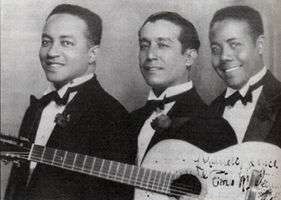Trio Matamoros
| Trío Matamoros | |
|---|---|
|
Trío Matamoros, ca. 1930. From left to right: Rafael Cueto, Miguel Matamoros, Siro Rodríguez | |
| Background information | |
| Origin | Havana, Cuba |
| Genres | |
| Years active | 1925-1961 |
| Labels | Victor, Seeco |
| Past members |
Miguel Matamoros Rafael Cueto Siro Rodríguez |
The Trío Matamoros was one of the most popular Cuban trova groups. It was formed in 1925 by Miguel Matamoros (8 May 1894 in Santiago de Cuba – 15 April 1971; guitar), Rafael Cueto (14 March 1900 in Santiago de Cuba – 7 August 1991; guitar) and Siro Rodríguez (9 December 1899 in Santiago de Cuba – Regla, 29 March 1981; maracas and claves). All three were singers and composers.
The Trío Matamoros played boleros and son. They toured all Latin America and Europe and recorded in New York. In 1940 Guillermo Portabales performed with the trio. Matamoros expanded the trio into a conjunto (Conjunto Matamoros) for a trip to Mexico and hired the young Beny Moré as singer from 1945 to 1947. They recorded many 78 rpm records and LPs; some of their output is available on CDs. The group were renowned for the harmony of their voices, and the quality of the lyrics.
Miguel Matamoros was one of the greatest and most prolific composers of Cuban son. His first hit was "El que siembra su maíz" (He who sows his corn), followed by classics such as "Lágrimas negras" (Black tears) and "Son de la loma" (They are from the hill).[1] The group, whose members stayed together for 35 years, announced their disbandment in May 1961.[2][3] Their last concert had taken place in New York the year before.[4]
References
- ↑ Sublette, Ned 2004. Cuba and its music: from the first drums to the mambo. Chicago, p367.
- ↑ Magaña S., Walter G. (July 2006). "Matamoros y su música". Herencia Latina. Retrieved July 26, 2017.
- ↑ Rodríguez Domínguez, Ezequiel. (1985). El Trío Matamoros: treinta y cinco años de música popular. La Habana: Editorial Arte y Cultura.
- ↑ Díaz Ayala, Cristóbal (Fall 2013). "Trío Matamoros" (PDF). Encyclopedic Discography of Cuban Music 1925-1960. Florida International University Libraries. Retrieved 16 April 2015.
